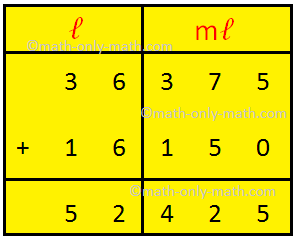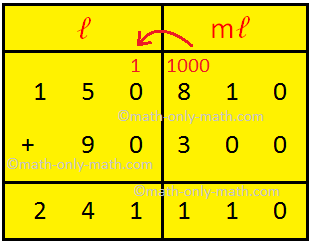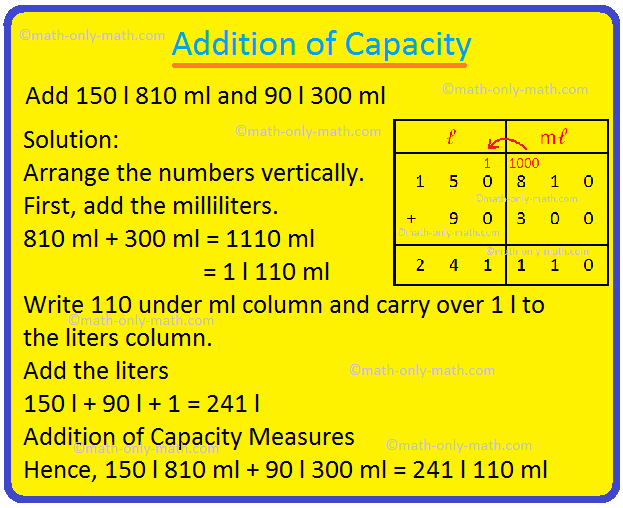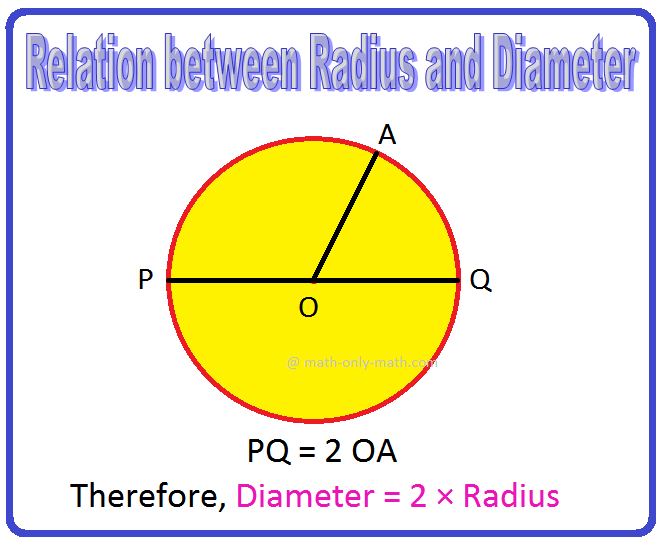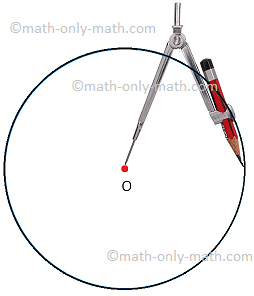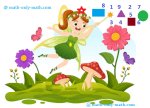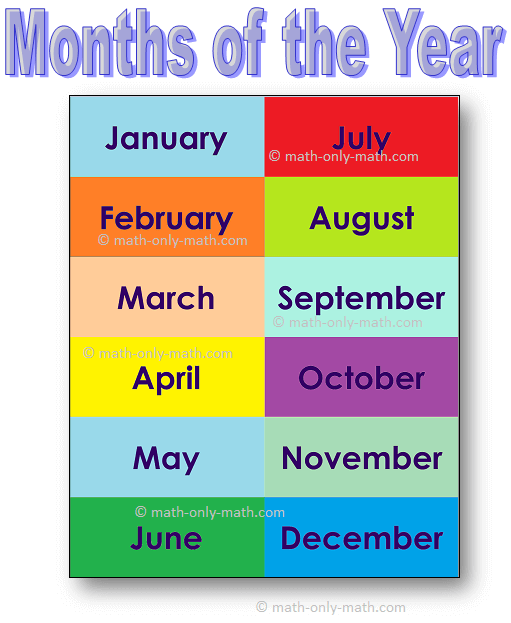Addition of Capacity
In addition of capacity we will learn how to add the different units of capacity and volume together. While adding we need to follow that the units of capacity i.e., liter and milliliter are converted into milliliters before addition and then follow the simple addition process.
We will learn two different methods to solve addition using the standard unit and smaller unit of capacity. Students can practice both the methods.
(i) Adding units with conversion into milliliters
(ii) Adding units without conversion into milliliters
We can add two or more units of capacity l and ml just like ordinary numbers.
Worked-out examples on addition of capacity and volume:
1. Add 3 l 600 ml and 6 l 300 ml
Solution:
Method 1 (with conversion into milliliters):
We know, 1 liter = 1000 milliliters
Now liter (l) and milliliters (ml) are converted into ml before doing addition and then we need to follow the simple addition process.
3 l 600 ml = (3 × 1000) ml + 600 ml = 3000 ml + 600 ml = 3600 milliliters
6 l 300 ml = (6 × 1000) ml + 300 ml = 6000 ml + 300 ml = 6300 milliliters
Now sum,
3600 ml
+ 6300 ml
9900 ml
= 9 l 900 ml
Therefore, 3 l 600 ml + 6 l 300 ml = 9 l 900 ml
Method 2 (without conversion into milliliters):
Here l and ml are arranged in different columns and then added like ordinary numbers.
(i) l and ml are arranged column-wise
(ii) 600 ml + 300 ml = 900 ml
(iii) 3 l + 6 l = 9 l
l ml
3 600
+ 6 300
9 900
= 9 l 900 ml
Therefore, sum of 3 l 600 ml and 6 l 300 ml = 9 l 900 ml.
2. Add 5 l 725 ml and 8 l 450 ml
Solution:
Method 1 (with conversion into milliliters):
We know, 1 liter = 1000 milliliters
Now liter (l) and milliliters (ml) are converted into ml before doing addition and then we need to follow the simple addition process.
5 l 725 ml = (5 × 1000) ml + 725 ml = 5000 ml + 725 ml = 5725 milliliters
8 l 450 ml = (8 × 1000) ml + 450 ml = 8000 ml + 450 ml = 8450 milliliters
Now sum,
1
5725 ml
+ 8450 ml
14175 ml
= 14 l 175 ml
Therefore, 5 l 725 ml + 8 l 450 ml = 14 l 175 ml
Method 2 (without conversion into milliliters):
Here l and ml are arranged in different columns and then added like ordinary numbers.
(i) l and ml are arranged column-wise
(ii) 725 ml + 450 ml = 1 l 175 ml.
175 ml is placed under ml. 1 l is taken in l column.
(iii) 1 l + 5 l + 8 l = 14 l
l ml
1
5 725
+ 8 450
14 175
= 14 l 175 ml
Therefore, sum of 5 l 725 ml and 8 l 450 ml = 14 l 175 ml.
More solved examples on addition of capacity where the method is mentioned in the given question.
3. Add 17 l 387 ml, 7 l 750 ml and 9 l without conversion into milliliters
Solution:
Without conversion into milliliters here l and ml are arranged in different columns and then added like ordinary numbers.
(i) l and ml are arranged column-wise
(ii) 387 ml + 750 ml = 1 l 137 ml.
137 ml is placed under ml. 1 l is taken in l column.
(iii) 1 l + 17 l + 7 l + 9 l = 34 l
l ml
21 1
17 387
7 750
+ 9 000
34 137
= 34 l 137 ml
Therefore, sum of 17 l 387 ml, 7 l 750 ml and 9 l = 34 l 137 ml.
4. Add 13 l 250 ml, 8 l 750 ml and 6 l with conversion into milliliters
Solution:
With conversion into milliliters here we will do the addition process.
We know, 1 liter = 1000 milliliters
Now liter (l) and milliliters (ml) are converted into ml before doing addition and then we need to follow the simple addition process.
13 l 250 ml = (13 × 1000) ml + 250 ml = 13000 ml + 250 ml = 13250 milliliters
8 l 750 ml = (8 × 1000) ml + 750 ml = 8000 ml + 750 ml = 8750 milliliters
6 l = (6 × 1000) ml = 6000 milliliters
Now sum,
111
13250 ml
8750 ml
+ 6000 ml
28000 ml
= 28 l 000 ml
= 28000 ml
Therefore, 13 l 250 ml + 8 l 750 ml + 6 l = 28000 ml
5. Add 36 l 275 ml and 16 l 150 ml.
|
Solution: Arrange the numbers vertically. First, add the milliliters. 275 ml + 150 ml = 425 ml Add the liters 36 l + 16 l = 52 l |
Hence, 36 l 275 ml + 16 l 150 ml = 52 l 425 ml
6. Add 150 l 810 ml and 90 l 300 ml
Solution:
|
Arrange the numbers vertically. First, add the milliliters. 810 ml + 300 ml = 1110 ml = 1 l 110 ml Write 110 under ml column and carry over 1 l to the liters column. Add the liters 150 l + 90 l + 1 = 241 l |
Hence, 150 ℓ 810 mℓ + 90 ℓ 300 mℓ = 241 ℓl 110 mℓ
For addition, write the number of mℓ and ℓ in separate columns then add like ordinary numbers. starting from the right.
7. Add 27 ℓ 450 mℓ & 52 ℓ 120 mℓ.
Solution:
mℓ ℓ
27 450
+ 52 120
79 570
Answer: 79 mℓ 570 mℓ
8. Add 214 ℓ 321 mℓ, 426 ℓ 932 mℓ & 358 ℓ 416 mℓ.
Solution:
mℓ ℓ
1 1
2 1 4 3 2 1
4 2 6 9 3 2
+ 3 5 8 4 1 6
9 9 9 6 6 9
Answer: 999 mℓ 669 mℓ
Word Problems on Addition of Capacity and Volume:
9. Finn purchased 3 l 250 ml of milk on Monday, 2 l 750 ml on Wednesday and 3 l 500 ml on Friday. How much milk did Finn purchased during these three days?
Solution:
1 1
Milk purchased on Monday = 3 l 250 ml
Milk purchased on Wednesday = 2 l 750 ml
Milk purchased on Friday = 3 l 500 ml
+
Therefore, total milk purchased during these 3 days = 9 l 500 ml
The above problems on addition of capacity will help the students to practice the worksheet on adding the different units with conversion or without conversion.
Questions and Answers on Addition of Capacity:
I. Add the following:
(i) 7 l 152 ml + 2 l 339 ml
(ii) 5 l 240 ml + 7 l 860 ml
(iii) 70 l 000 ml + 22 l 504 ml
(iv) 13 l 1290 ml + 18 l 160 ml
(v) 32 l 540 ml + 18 l + 210 ml
(vi) 19 l 300 ml + 3 l 900 ml
(vii) 62 l 200 ml + 15 ml 385 ml
(viii) 120 l + 625 ml + 30 l 750 ml
(ix) 21 l 845 ml + 32 l 116 ml + 38 l 082 ml
Answers:
I. (i) 9 l 491 ml
(ii) 13 l 100 ml
(iii) 92 l 504 ml
(iv) 31 l 450 ml
(v) 50 l 750 ml
(vi) 23 l 200 ml
(vii) 77 l 585 ml
(viii) 151 l 375 ml
(ix) 92 l 43 ml
II. Add the following:
|
(i) |
mℓ ℓ 21 27 + 48 32 _ _______ _ |
(ii) |
mℓ ℓ 86 45 + 12 20 _ _______ _ |
|
(iii) |
mℓ ℓ 27 10 + 11 25 _ _______ _ |
(iv) |
mℓ ℓ 32 94 + 60 05 _ _______ _ |
|
(v) |
mℓ ℓ 17 826 + 23 578 _ _______ __ |
(vi) |
mℓ ℓ 46 950 + 39 475 _ ________ _ |
|
(vii) |
mℓ ℓ 76 586 + 45 674 _ _______ __ |
(viii) |
mℓ ℓ 51 700 + 48 300 _ ________ _ |
|
(ix) |
mℓ ℓ 209 68 214 09 + 116 00 _ _______ __ |
(x) |
mℓ ℓ 423 00 147 05 + 208 79 _ _______ __ |
|
(xi) |
mℓ ℓ 126 90 103 70 + 264 50 _ _______ __ |
(xii) |
mℓ ℓ 210 73 216 08 + 205 98 _ _______ __ |
|
(xiii) |
mℓ ℓ 205 853 369 786 + 8 678 _ ________ __ |
(xiv) |
mℓ ℓ 125 675 465 850 + 310 625 _ ________ __ |
|
(xv) |
mℓ ℓ 318 564 237 658 + 8 678 _ ________ __ |
(xvi) |
mℓ ℓ 275 750 117 650 + 10 545 _ ________ __ |
Answer:
2. (i) 69 ℓ 59 mℓ
(ii) 98 ℓ 65 mℓ
(iii) 38 ℓ 35 mℓ
(iv) 92 ℓ 99 mℓ
(v) 41 ℓ 404 mℓ
(vi) 86 ℓ 425 mℓ
(vii) 122 ℓ 260 mℓ
(viii) 100 ℓ 00 mℓ
(ix) 53 ℓ 977 mℓ
(x) 77 ℓ 884 mℓ
(xi) 49 ℓ 510 mℓ
(xii) 63 ℓ 279 mℓ
(xiii) 584 ℓ 317 mℓ
(xiv) 902 ℓ 150 mℓ
(xv) 564 ℓ 600 mℓ
(xvi) 403 ℓ 945 mℓ
● Related Concepts
● Conversion of Standard Unit of Capacity
From Addition of Capacity to HOME PAGE
Didn't find what you were looking for? Or want to know more information about Math Only Math. Use this Google Search to find what you need.
Recent Articles
-
Symmetrical Shapes | One, Two, Three, Four & Many-line Symmetry
Apr 23, 24 04:50 PM
Symmetrical shapes are discussed here in this topic. Any object or shape which can be cut in two equal halves in such a way that both the parts are exactly the same is called symmetrical. The line whi… -
Relation between Diameter Radius and Circumference |Problems |Examples
Apr 23, 24 03:15 PM
Relation between diameter radius and circumference are discussed here. Relation between Diameter and Radius: What is the relation between diameter and radius? Solution: Diameter of a circle is twice -
Circle Math | Terms Related to the Circle | Symbol of Circle O | Math
Apr 22, 24 01:35 PM
In circle math the terms related to the circle are discussed here. A circle is such a closed curve whose every point is equidistant from a fixed point called its centre. The symbol of circle is O. We… -
Preschool Math Activities | Colorful Preschool Worksheets | Lesson
Apr 21, 24 10:57 AM
Preschool math activities are designed to help the preschoolers to recognize the numbers and the beginning of counting. We believe that young children learn through play and from engaging -
Months of the Year | List of 12 Months of the Year |Jan, Feb, Mar, Apr
Apr 20, 24 05:39 PM
There are 12 months in a year. The months are January, February, march, April, May, June, July, August, September, October, November and December. The year begins with the January month. December is t…
